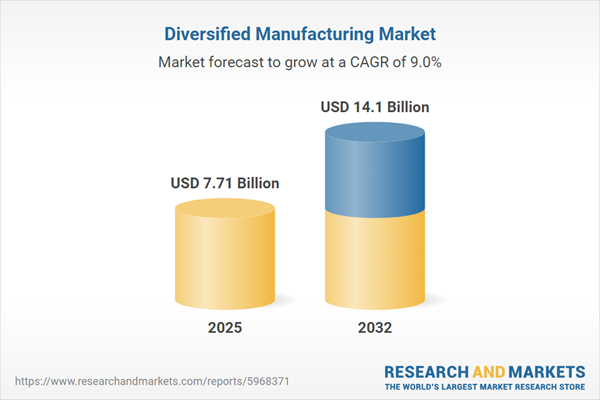Speak directly to the analyst to clarify any post sales queries you may have.
The diversified manufacturing market is evolving rapidly, driven by technological advances, shifting regulatory landscapes, and increasing demand for smart, sustainable production. Senior decision-makers must navigate these disruptions and opportunities to maintain resilience and competitiveness.
Market Snapshot: Diversified Manufacturing Market Size and Growth
The Diversified Manufacturing Market grew from USD 7.08 billion in 2024 to USD 7.71 billion in 2025. It is expected to continue expanding at a CAGR of 8.99%, projected to reach USD 14.10 billion by 2032.
Scope & Segmentation of the Diversified Manufacturing Market
- Product Types: Aerospace components, automotive parts (including chassis, electrical, engine, and transmission components), heavy machinery, and light equipment.
- End-Use Industries: Aerospace and defense, automotive, construction, electronics, and electrical sectors.
- Material Categories: Composite (fiber reinforced, resin matrix), metals (ferrous, non-ferrous), plastics (thermoplastics, thermosets), and rubber (natural, synthetic).
- Manufacturing Technologies: Additive manufacturing (material extrusion, powder bed fusion, vat photopolymerization), automation and robotics (autonomous mobile robots, collaborative robots, industrial robots), CNC machining (milling, routing, turning), digital twin and simulation, IoT and Industry 4.0 (connectivity, data analytics, cybersecurity).
- Sales Channels: Aftermarket services (including maintenance and spare parts), direct sales (bulk, OEM contracts), distributor sales (authorized, value-added resellers), and online channels (company websites, e-commerce platforms).
- Regions Covered: Americas (North America, Latin America), Europe, Middle East & Africa, and Asia-Pacific, with profiling for major countries such as the United States, Germany, China, India, and Brazil.
- Leading Companies: Hitachi, Siemens Aktiengesellschaft, General Electric, Mitsubishi Heavy Industries, Honeywell International, 3M, Danaher Corporation, ABB Ltd.
Key Takeaways for Senior Decision-Makers
- Digital integration through IoT, simulation, and automation technologies is reshaping production agility and enabling real-time optimization across facilities and value chains.
- Sustainability imperatives are guiding a transition toward lightweight composites, recycled inputs, and energy-efficient processes, especially in regulated and environmentally focused regions.
- Strategic supply chain diversification—including vendor qualification and alternative sourcing—is strengthening risk management and supporting business continuity.
- Partnerships with technology providers and research institutes are accelerating innovation in materials and manufacturing practices, ensuring competitive value creation.
- The growth of smart aftermarket services and data-driven offerings is unlocking recurring revenue streams while enhancing customer satisfaction and equipment lifecycle value.
Assessing Tariff Impact on Sourcing Strategies
Recent U.S. tariff adjustments have prompted manufacturers to reassess their procurement strategies, leading to realignment of supplier networks and accelerated nearshoring. In response, many organizations are adopting scenario modeling and advanced analytics to evaluate various sourcing and design options, improving their preparedness for future trade policy changes and input cost fluctuations. Additionally, changing duty structures are influencing the selection of materials and exploration of composites to optimize costs and maintain competitiveness.
Methodology & Data Sources
This report uses a combined qualitative and quantitative research methodology. Primary research includes interviews with industry leaders and functional experts, while secondary research reviews white papers and industry publications. Quantitative data is sourced from trade statistics, patent databases, and company financial reports, cross-validated for accuracy and reliability.
Why This Report Matters to Industry Leaders
- Enables strategic planning by providing a comprehensive understanding of emerging technologies, regulatory trends, and supply chain dynamics in diversified manufacturing.
- Supports opportunity identification by analyzing recent advances, evolving end-user demands, and shifting regional drivers across key industry segments.
- Facilitates risk mitigation with actionable insights on tariff exposure, procurement options, and the competitive landscape in both developed and emerging markets.
Conclusion & Strategic Direction
Diversified manufacturing is at a turning point marked by continuous digital transformation, new materials, and evolving supply networks. Informed strategic choices will empower companies to realize greater adaptability, sustained innovation, and long-term market leadership.
Additional Product Information:
- Purchase of this report includes 1 year online access with quarterly updates.
- This report can be updated on request. Please contact our Customer Experience team using the Ask a Question widget on our website.
Table of Contents
3. Executive Summary
4. Market Overview
7. Cumulative Impact of Artificial Intelligence 2025
Companies Mentioned
The companies profiled in this Diversified Manufacturing market report include:- Hitachi, Ltd.
- Siemens Aktiengesellschaft
- General Electric Company
- Mitsubishi Heavy Industries, Ltd.
- Honeywell International Inc.
- 3M Company
- Danaher Corporation
- ABB Ltd
Table Information
| Report Attribute | Details |
|---|---|
| No. of Pages | 189 |
| Published | October 2025 |
| Forecast Period | 2025 - 2032 |
| Estimated Market Value ( USD | $ 7.71 Billion |
| Forecasted Market Value ( USD | $ 14.1 Billion |
| Compound Annual Growth Rate | 8.9% |
| Regions Covered | Global |
| No. of Companies Mentioned | 9 |









